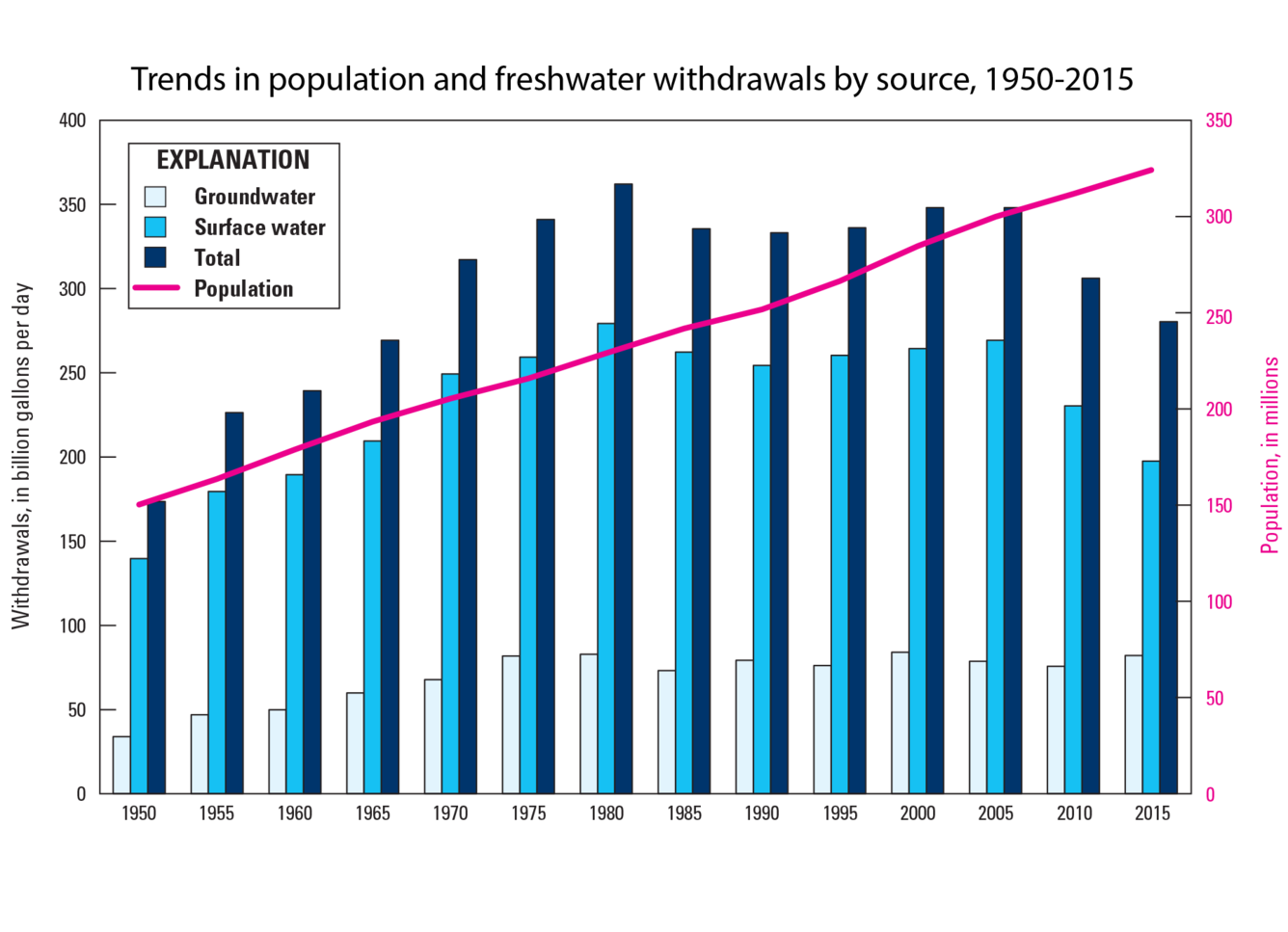Map of the U.S. by state, showing total water withdrawals, 2015
Map of the U.S. by state, showing total water withdrawals, 2015Map of the U.S. by state, showing total water withdrawals, 2015

An official website of the United States government
Here's how you know
Official websites use .gov
A .gov website belongs to an official government organization in the United States.
Secure .gov websites use HTTPS
A lock () or https:// means you’ve safely connected to the .gov website. Share sensitive information only on official, secure websites.
The Nation's surface-water resources—the water in the nation's rivers, streams, creeks, lakes, and reservoirs—are vitally important to our everyday life.
• Water Science School HOME • Surface Water topics • Water Use topics •
The main uses of surface water include drinking-water and other public uses, irrigation uses, and for use by the thermoelectric-power industry to cool electricity-generating equipment. The majority of water used for thermoelectric power, public supply, irrigation, mining, and industrial purposes came from surface-water sources. Of all the water used in the United States in 2015 (about 322,000 million gallons per day (Mgal/d), fresh and saline), about 74 percent (237,000 Mgal/d) came from surface-water sources. (All 2015 water use information is from the report Estimated use of water in the United States in 2015.) Water from groundwater sources accounted for the remaining 26 percent.
About 70 percent of the freshwater used in the United States in 2015 came from surface-water sources. The other 30 percent came from groundwater. Surface water is an important natural resource used for many purposes, especially irrigation and public supply (supplying people with drinking water and for everyday uses).



Source: Estimated Water Use in the United States in 2015

Want to know more about surface water use in the United States? Follow me to the Surface Water Use website!
Below are science topics related to surface water use in the U.S.
Below are multimedia items related to surface water use in the U.S.

Map of the U.S. by state, showing total water withdrawals, 2015
Map of the U.S. by state, showing total water withdrawals, 2015

Bar chart showing use of water in 2015, by state and category of use
Bar chart showing use of water in 2015, by state and category of use
Source and Use of Water in the United States, 2015
This diagram uses a "cylinder and pipe" layout to show the source (surface water or groundwater) of the Nation's water and for what purposes the water was used in 2015. The data are broken out for each category of use by surface water and groundwater as the source.
Source and Use of Water in the United States, 2015
This diagram uses a "cylinder and pipe" layout to show the source (surface water or groundwater) of the Nation's water and for what purposes the water was used in 2015. The data are broken out for each category of use by surface water and groundwater as the source.
Below are publications related to surface water use in the U.S.
The Nation's surface-water resources—the water in the nation's rivers, streams, creeks, lakes, and reservoirs—are vitally important to our everyday life.
• Water Science School HOME • Surface Water topics • Water Use topics •
The main uses of surface water include drinking-water and other public uses, irrigation uses, and for use by the thermoelectric-power industry to cool electricity-generating equipment. The majority of water used for thermoelectric power, public supply, irrigation, mining, and industrial purposes came from surface-water sources. Of all the water used in the United States in 2015 (about 322,000 million gallons per day (Mgal/d), fresh and saline), about 74 percent (237,000 Mgal/d) came from surface-water sources. (All 2015 water use information is from the report Estimated use of water in the United States in 2015.) Water from groundwater sources accounted for the remaining 26 percent.
About 70 percent of the freshwater used in the United States in 2015 came from surface-water sources. The other 30 percent came from groundwater. Surface water is an important natural resource used for many purposes, especially irrigation and public supply (supplying people with drinking water and for everyday uses).



Source: Estimated Water Use in the United States in 2015

Want to know more about surface water use in the United States? Follow me to the Surface Water Use website!
Below are science topics related to surface water use in the U.S.
Below are multimedia items related to surface water use in the U.S.

Map of the U.S. by state, showing total water withdrawals, 2015
Map of the U.S. by state, showing total water withdrawals, 2015

Bar chart showing use of water in 2015, by state and category of use
Bar chart showing use of water in 2015, by state and category of use
Source and Use of Water in the United States, 2015
This diagram uses a "cylinder and pipe" layout to show the source (surface water or groundwater) of the Nation's water and for what purposes the water was used in 2015. The data are broken out for each category of use by surface water and groundwater as the source.
Source and Use of Water in the United States, 2015
This diagram uses a "cylinder and pipe" layout to show the source (surface water or groundwater) of the Nation's water and for what purposes the water was used in 2015. The data are broken out for each category of use by surface water and groundwater as the source.
Below are publications related to surface water use in the U.S.
